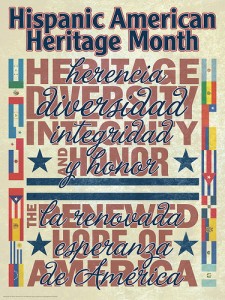6 Ways To Think About Hispanic Heritage Month
 Although many Latinos celebrate our distinct contributions to the fabric of America throughout the year, Hispanic Heritage Month is a time when the rest of the country is invited to understand both our unique transnational heritage and our role in shaping the future of our country. However, all too often, many Latinos are simply unaware of the broader features of our community. This September 15 – October 15 offers every Latino community organizer, activist and politico a chance to familiarize themselves with contemporary Latino trends.
Although many Latinos celebrate our distinct contributions to the fabric of America throughout the year, Hispanic Heritage Month is a time when the rest of the country is invited to understand both our unique transnational heritage and our role in shaping the future of our country. However, all too often, many Latinos are simply unaware of the broader features of our community. This September 15 – October 15 offers every Latino community organizer, activist and politico a chance to familiarize themselves with contemporary Latino trends.
Here are six major areas to reconsider:
SCALE: According to the most recent decennial census, the U.S. Latino population, including the Latino population of Puerto Rico, is now over 54.2 million and has now become America’s largest ethnic minority as well as the largest mestizo or population of mixed racial origins in the country. Due to the extraordinary rate of growth that the Latino population has experienced in recent decades, the American Latino population is now the second largest Hispanic population worldwide. Another way to conceptualize the scale of the U.S. Latino population, including Puerto Rico, is to visualize it as approximately half the size of the entire population of Mexico.
FAMILIES: This massive population is also comprised of over 11 million Latino families distributed across every region of the U.S. and Puerto Rico. Of these families, nearly two-thirds were comprised of a married couples. Nationally, over one-third of the U.S. Latino population was comprised of families who contained a married couple with children under the age of 18. Inside of these homes, over 35 million Latinos over the age of 5 speak Spanish with family members inside of the house–this number is equivalent to the 2000 U.S. Latino population.
AGE: If the U.S. Latino population were segmented into three distinct age groups, 34.3% would be under 18 years of age, 59.8% would be adults ages 18-64 and 5.5% would be senior citizens over 65.
VOTING: Although the U.S. Latino population has grown rapidly, Latino residents with citizenship who are at least 18 years of age and eligible to vote only amount to less than half of the overarching population. During the 2008 presidential election, which is recognized as the election that produced the highest Latino voter turnout in history, only 9.7 million or half of Latinos eligible to votes participated in that election. However, groups such as the National Association of Latino Elected Officials (NALEO) have recently projected that by the 2012 presidential, 12.2 million Latinos will vote.
EDUCATION: Due to the increasing proportion of young Latinos in the United States, within the K-12 grade levels, this sector now represents 20% of all primary and high school students. However, within higher education, only 12% of undergraduate and graduate students are of Latino ancestry. Over two million Latinos have undergraduate degrees, but only one million Latinos in America have an advanced degree (i.e., MA, MFA, JD, PhD). Across the U.S. Latino community, however, the increased number of new high school graduates as well as undergraduate and graduate degree holders has become disproportionately female driven across the last two decades.
MILITARY SERVICE: Equivalent to the total scale of Latino advanced degree holders, one out of 50 Latinos in the United States are veterans of the armed forces.
Harnessing the future energy of this burgeoning sector of the American populace requires us all to not only reflect on how much Latino population growth has transpired in this last decade alone, but how along with this growth emerges tremendous responsibility.
[Photo By familymwr]
